ISO’s Public Protection Classification (PPC) program measures the effectiveness of municipal fire suppression efforts in communities around the country – and helps insurance companies determine premiums for property owners in those communities. In general, the price of fire insurance in a community with a good PPC is substantially lower than in a community with a poor PPC, assuming all other factors are equal.
So, to serve your community, you want to earn the best possible PPC. This article will show you how the program works – and how you can improve your ISO classification.
How the PPC Program Works
To evaluate your community, ISO’s expert staff collects information about your municipal fire-suppression efforts. We use a manual called the Fire Suppression Rating Schedule (FSRS) to assign credit points for various features of your fire protection, including your water supply system, your fire alarm and communications systems, and your fire department. The maximum score is 100 points.
Based on your score, we assign a Public Protection Classification – a number from 1 to 10. Class 1 represents the best public protection, and Class 10 indicates less than the minimum recognized protection.
- Water supply. The most fundamental improvement many communities can make is in the water supply. If your water supply doesn’t meet minimum FSRS criteria, you generally can’t improve beyond a Class 9. However, the FSRS does recognize alternative water supply systems, including dry hydrants, suction points, large-diameter hose (LDH) relays and hauled water using tanker shuttles.
Credit for an alternative water-supply system can be up to 35 points and will allow your jurisdiction to improve from a Class 9. ISO may recognize your tanker-shuttle operation if it can deliver a minimum flow of 250 gpm, uninterrupted, for two hours, and if the water source is available and accessible 24 hours a day, 365 days a year. The FSRS recognizes agreements with neighboring fire departments to supplement the response of tankers and/or supply-site pumpers.
ISO has introduced Class 8B for communities that cannot meet the minimum 250 gpm uninterrupted flows for a two-hour duration in all or a part of their fire-protection area. To achieve a Class 8B classification, you must be able to deliver 200 gpm, uninterrupted, for 20 minutes within five minutes of arrival of the first apparatus at the fire. In addition, your community must score at least five points out of 10 on Receiving and Handling of Fire Alarms and at least 20 points out of 50 on the Fire Department evaluation.
If your community has a public water-supply system with fire hydrants, you can earn up to three points for maintaining the hydrants in good condition and inspecting them twice a year. The inspection program should include flushing the hydrants and conducting a pressure test. The public water authority may perform those tasks.
- Fire alarm and communications systems. You may be able to get credit by improving your department’s tools for receiving and handling alarms. For example, you can get up to two points by equipping all fire suppression personnel with portable radio voice receivers. If you use an outside siren or a tone pager carried by all personnel, you are eligible for one point.
A possible improvement that should not cost your department any money is simply getting the telephone company to list your emergency and non-emergency (business) numbers in the local directory. You can earn up to 0.4 points.
- Fire department. Other than water supply, the single most important item in the FSRS is company personnel. You can earn up to 15 points for personnel, depending on the average number of on-duty firefighters available in fire stations to respond to a structure fire. To evaluate your department, ISO will review one year’s worth of response records.
Because of the restricted availability of volunteer firefighters, ISO credits three volunteers as equivalent to one on-duty firefighter. Some volunteer departments have members sleep at the fire station. For the time that the volunteers are on duty at the station, ISO considers them as equivalent to on-duty firefighters.
The FSRS encourages training for firefighters. You can earn up to 3.15 points for a facility to train personnel in suppressing structure fires. Your department does not have to own the facility to get maximum credit. If you arrange for off-site training, we’ll confirm that you have permission to use the facility, that you have actually used it within the last year and that you can adequately protect the community while your personnel are away. If you don’t have access to a training facility, but conduct training on streets or in other open areas, you can still receive partial credit.
You can also receive credit for company training at your fire station. If each member of your company receives 20 hours a month of training in fighting structure fires, you can earn up to 2.25 points. The training can use such media as video, CD-ROM, computer-based training, and closed-circuit or satellite TV.
Your department’s equipment and testing can make a big difference in your score. FSRS Table 512.A (Pumper Equipment and Hose) lists 27 items worth up to a total of 10 points. Hose, nozzles, breathing apparatus, testing of apparatus and hose, radios and a heavy-stream device are particularly important. Visit the ISO Mitigation Online website (www.isomitigation.com/fire71.html) for more information.
Finally, you may have heard that ISO has criteria for the age of your apparatus. Not true. Instead, ISO evaluates pump capacity, demonstrated by a test. You may be able to improve your score by buying used or refurbished apparatus, or by maintaining your existing apparatus so it meets standards for capacity. You can also earn up to 1.53 points just for conducting pump tests – something your department can do on its own.
It’s Up to You
Improving your community’s ISO classification will require resources and hard work. You and your community’s other leaders will have to make decisions about priorities and budgets.
The suggestions in this article may not be appropriate for every fire department, and they are not all inclusive. You will need to weigh the needed criteria for an improved classification against your department’s other important responsibilities, including emergency medical responses, hazardous-material responses, fires other than structure fires, technical rescue and public service calls. But the rewards for your department and your community can be significant.
For additional information, visit the ISO Mitigation Online website at www.isomitigation.com or telephone ISO at 800-444-4554.
Edward F. Straw and Dennis Gage will present “Understanding ISO’s Fire Grading Program” at Firehouse Expo 2004 in Baltimore, July 13-18.
Edward F. Straw is senior technical coordinator of the Public Protection Grading Unit for the Insurance Services Office Inc. (ISO). He assists in the oversight of ISO’s nationwide Fire Suppression Rating Schedule (FSRS) and Public Protection Classification (fire grading) activities. Straw is a contributing member to the National Fire Protection Association (NFPA) “Forest & Rural Fire Protection” and “Emergency Service Communications Systems” Technical Committees. Also, he is a contributing member to the American Water Works Association (AWWA) Standards Committee on “Wet and Dry Barrel Fire Hydrants.” Straw holds a bachelor of science degree in aviation engineering technology from Western Michigan University and has been in the insurance information business for over 33 years. He may be contacted at [email protected] or at 770-923-9898 ext. 214.





